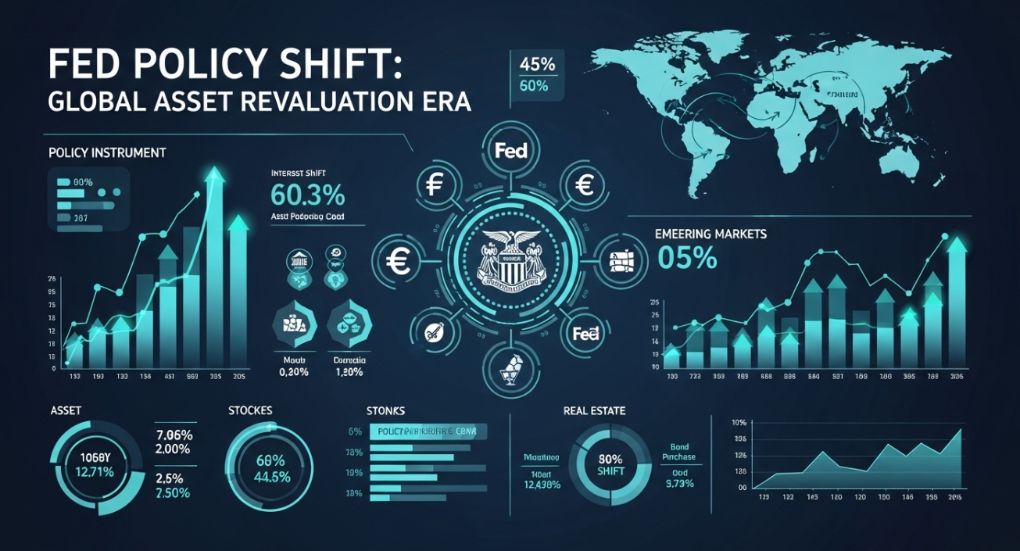The Federal Reserve's policy "double whammy" has ignited global markets, and the interconnection among the four major assets—US dollar, gold, cryptocurrencies, and US stocks—is undergoing profound changes.
The Federal Reserve's policy moves in October have become the focus of global capital markets. On one hand, the Fed may pause quantitative tightening; on the other, market expectations for a rate cut in October are as high as 99%.
Behind this policy shift are multiple pressures, including a slowdown in US economic growth, a weakening labor market, and government shutdown risks. This article will analyze in depth how these two major policy shifts impact the US dollar, gold, crypto markets, and US stocks, revealing the connections and opportunities for investors.

01 Policy Giant Turns: The Fed's Dual Actions
In the early hours of October 15 (GMT+8), Federal Reserve Chair Jerome Powell delivered a speech at the National Association for Business Economics event in Philadelphia, sending a strong signal of policy shift. This speech not only reinforced market expectations for rate cuts but also hinted that the more than three-year-long quantitative tightening (QT) is about to end.
Stopping QT: A Cushion for Liquidity Tightening
● Powell made it clear, "We may be approaching a pause in QT in the coming months." Since the start of QT in June 2022, the Fed's balance sheet has shrunk from a peak of nearly $9 trillion to about $6.6 trillion now.
This move aims to address signs of liquidity tightening. Powell acknowledged that as repo rates rise, there are some signs of tightening in the money market, and the Fed wants to take a "very cautious" approach to avoid a repeat of the September 2019 money market stress.
Rate Cut Expectations: Labor Market Alarm Bells
● The strengthening of rate cut expectations comes directly from the deterioration of the labor market. Powell pointed out, "Downside risks to the employment situation are rising," which has changed the Fed's risk balance assessment.
According to the CME "FedWatch" tool, after Powell's speech, the probability of a 25 basis point rate cut by the Fed in October is as high as 97.3%, and the probability of a cumulative 50 basis point cut by December is 93.5%.
Regulatory Easing: Institutional Dividends for the Crypto Market
● 2025 will become a "watershed" for US crypto regulation. In August, the Fed ended its "Novel Activities Supervision Program," bringing banks' crypto businesses into its regular regulatory process.
At the same time, agencies such as the FDIC and OCC have also abolished a series of restrictive rules, clearing the way for traditional financial institutions to enter. This series of policy adjustments marks a fundamental shift in regulatory thinking: from "defend first, observe later" to "incorporate into the framework, regulate development."
02 Four Major Assets Interact: An Overview at a Glance
The "policy double whammy" of the Fed pausing QT and rate cut expectations is reshaping the global asset landscape through three main channels: liquidity, risk aversion sentiment, and economic outlook.
The table below clearly shows the interconnection among these assets:
Asset Class | Main Impact Logic | Expected Performance | Key Evidence |
US Dollar Index | Rate cuts weaken the dollar's interest rate advantage, capital outflows | Expected to weaken | US Dollar Index below $100 |
Gold | Safe haven demand + easing policy + central bank gold purchases | Significant positive | Gold hits all-time high, becomes first asset with total market value over $30 trillion |
Crypto Market | Regulatory easing VS short-term risk aversion sentiment | Divergent volatility | Bitcoin rebounds after hitting a four-month low, ETF net outflows |
US Stocks | Liquidity support VS economic concerns | Structural divergence | Tech stocks lead the decline, funds shift to defensive sectors |
As seen in the table, the impact paths of the Fed's policy shift on different assets vary— the US dollar is directly hit, gold enjoys dual benefits, while risk assets (US stocks and crypto markets) are caught in a tug-of-war between economic concerns and improved liquidity.
03 Transmission Mechanism Analysis: How Assets Are Revalued
Dollar Under Pressure: The Downward Channel Under Rate Cut Pressure
● The Fed's loose monetary policy usually puts downward pressure on the US dollar. When the Fed cuts rates or pauses QT, the yield advantage of dollar assets is weakened, leading to capital outflows from dollar assets.
The US Dollar Index near 98.2 reflects the market's strong expectations for a Fed policy shift. Historically, the dollar's trend is highly correlated with Fed monetary policy. The weakening trend of the US Dollar Index may be further strengthened with the implementation of the October rate cut.
Gold Shines: Dual Positives Push to All-Time Highs
● Driven by both the Fed's policy shift and geopolitical risks, gold has seen a strong rally. The Fed's pause in QT and rate cut expectations constitute dual positives for gold. On one hand, pausing QT alleviates concerns about further liquidity tightening; on the other, rate cuts lower the opportunity cost of holding gold.
● Spot gold prices once broke through $4,300/oz, hitting a record high and becoming the first asset in human history with a total market value exceeding $30 trillion.
Gold's strength also stems from a structural shift as global central banks continue to increase their holdings. Data from the World Gold Council shows that since 2022, global central bank gold purchases have surged, exceeding 1,000 tons for three consecutive years—double the annual average of 473 tons from 2010 to 2021.
Crypto Market: Opportunities and Risks Coexist
The impact of the Fed's policy shift on the crypto market is relatively complex, showing a clear duality.
● Policy easing brings positives. Regulatory clarity has removed barriers for traditional financial institutions to enter. BlackRock's bitcoin ETF surpassed $40 billion in scale within 200 days, indicating that institutional funds are accelerating their inflow.
● At the same time, Fed rate cuts may prompt some funds to flow out of money market funds and return to risk investments. Historical data shows that in the early stages of a Fed policy shift, crypto assets often rebound.
● Short-term adjustment pressure. Despite favorable policy winds, the crypto market still faces adjustment pressure in the near term. Bitcoin once fell below $104,000, hitting a nearly four-month low.
Some analysts are cautious about bitcoin's short-term trend. Ledn Chief Investment Officer Jon Glover expects that the bitcoin bull market has ended and the upcoming bear market will last at least until the end of 2026.
US Stocks: A Game Between Liquidity-Driven Gains and Performance Concerns
The impact of the Fed's policy shift on US stocks is also complex.
● Liquidity support. Rate cuts and a pause in QT mean improved liquidity in the financial system, which is positive for US stocks, especially rate-sensitive growth stocks.
Historical data shows that in the early stages of a Fed policy shift, US stocks usually rise, with the Nasdaq's decline narrowing from 2.12% to 0.76% after Powell's speech.
● Economic concerns exert pressure. However, this round of policy adjustment is also interpreted by the market as confirmation of economic downturn, which may suppress corporate earnings expectations.
The Fed's Beige Book points out that most regions have seen a slowdown in economic activity, with core sectors such as retail and real estate performing weakly, and consumer spending willingness continuing to decline.
04 Historical Comparison: The Uniqueness of This Cycle
To better understand the current market environment, it is very meaningful to compare this round of policy shift with historical periods:
Cycle Characteristics | 2008 Crisis-Driven Rate Cuts | 2019 Insurance Rate Cuts | 2025 Risk Management Rate Cuts |
Policy Background | Systemic financial crisis | Stable economy, risk prevention | Worsening labor market, sticky inflation |
Rate Cut Magnitude | Aggressive rate cuts + QE | Small adjustments, 3 rate cuts | Gradual steps, expected 2 times within the year |
Market Reaction | Stocks plunged then rebounded | Stocks rose moderately | Stock market structural divergence, crypto market volatility |
Crypto Market | Bitcoin not yet mature | Bitcoin rose over 80% in the year | Institutions accelerate entry, regulatory easing |
Main Risks | Financial system collapse | Trade war uncertainty | Sticky inflation, political interference with central bank independence |
The 2025 rate cut most resembles 2019: not an imminent crisis, but uncertainty from a combination of employment downturn and sticky inflation. It is neither as aggressive as 2008 nor as passive as 2001, but rather a "small-step easing to prevent recession and hedge risks".
05 Asset Correlations Change, Investment Logic Restructured
As shown in the above analysis, traditional asset correlations are being restructured under the backdrop of the Fed's policy shift.
● Negative correlation between the US dollar and gold strengthens: The weakening dollar and strengthening gold form a sharp contrast
● Positive volatility between gold and risk assets: Gold and US stocks break the traditional safe haven-risk asset pattern
● Crypto market's relationship with traditional assets becomes more complex: The crypto market no longer fully follows US stocks, showing independent volatility characteristics
The core driving force behind this change in correlation is the shift in market logic—from "bad news is good news" (bad economy = loose policy = market rises) to "bad news is bad news" (bad economy = lower earnings = market falls).
Research shows that the correlation between cryptocurrencies and traditional financial markets is deepening. The correlation coefficient between S&P 500 volatility and major crypto market prices has reached 0.7. This indicates that the crypto market is no longer isolated and is increasingly interconnected with the mainstream financial system.
The Fed's policy shift has become the core driving force for current asset revaluation. The pattern of a weakening dollar, strengthening gold, short-term adjustment in the crypto market, and structural divergence in US stocks may persist for the next one to two quarters.
Investors should pay attention to the CPI data released on October 24 (UTC+8) and the OPEC+ production meeting on November 2 (UTC+8), as these factors will provide key clues for judging the market's subsequent direction.
In a weak dollar cycle, asset rotation is accelerating. Seizing structural opportunities is more realistic than chasing broad-based rallies.

